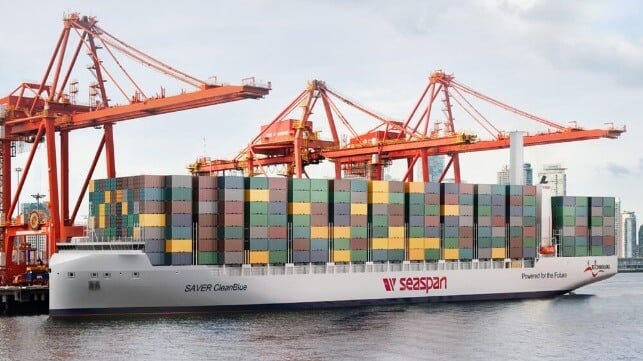Seaspan Reveals Design for Ammonia-Ready Feeder that Received AiP from LR

A new project involving containership owner Seaspan, Hamburg, Germany-based naval architecture firm Technolog, and Lloyd’s Register previewed a future design for container feeder ships. The concept is to create a future-proof ship that will be able to adapt including for the adoption of ammonia as an alternative fuel.
Technolog developed the design for a vessel that would be introduced using LNG as its fuel source. The design is ammonia-ready providing the opportunity to transition to the alternative fuel during the vessel’s operating lifecycle.
They provided a rendering but only reported the design is for a vessel that would be 650 feet (198 meters) in length. No capacity or other details were announced.
The rendering, however, shows a few unique elements including a forward-placed bridge at the bow but unlike other recent designs does not move the accommodation block forward. The traditional deckhouse is located behind 20 rows of containers with four additional rows aft.
Lloyd’s Register reports it awarded Approval in Principle (AiP) to Seaspan Corporation for its innovative “Next Generation Feeder Ship Design.” By completing the AiP process, Seaspan, Technolog, and Lloyd’s Register reported they have laid the groundwork for future advancements in feeder vessel technology in this rapidly evolving space. They attest that the design meets current market demands and anticipates future challenges and opportunities in the maritime industry.
LR, Seaspan, and Technolog, report they look forward to beginning work on phase 2 of this project, which will be a dual-fuel Ammonia Feeder Vessel.
The project builds on the previous work Seaspan Corporation has undertaken with LR and others. A year ago, Seaspan unveiled its design for a 15,000 TEU ammonia-fueled containership. That project was developed in partnership with the Maersk Mc-Kinney Moller Center for Zero Carbon Shipping, Foreship, and ABS.
Seaspan remains among the largest containership owners working with many of the major carriers. The company reports it has an operating fleet consisting of 165 vessels, with an additional 23 vessels under construction, delivering through to December 2024, Total fleet capacity will be approximately 1.9 million TEU when all the current vessels are delivered, which would rank the company sixth according to Alphaliners’ if it was operating as a single fleet. They would be just behind Hapag-Lloyd and ahead of major customers and now one of their investors, Ocean Network Express (ONE). Seaspan has also ordered six 10,800 CEU pure car, truck carrier (PCTC) newbuilds as it looks to diversify its operations.
